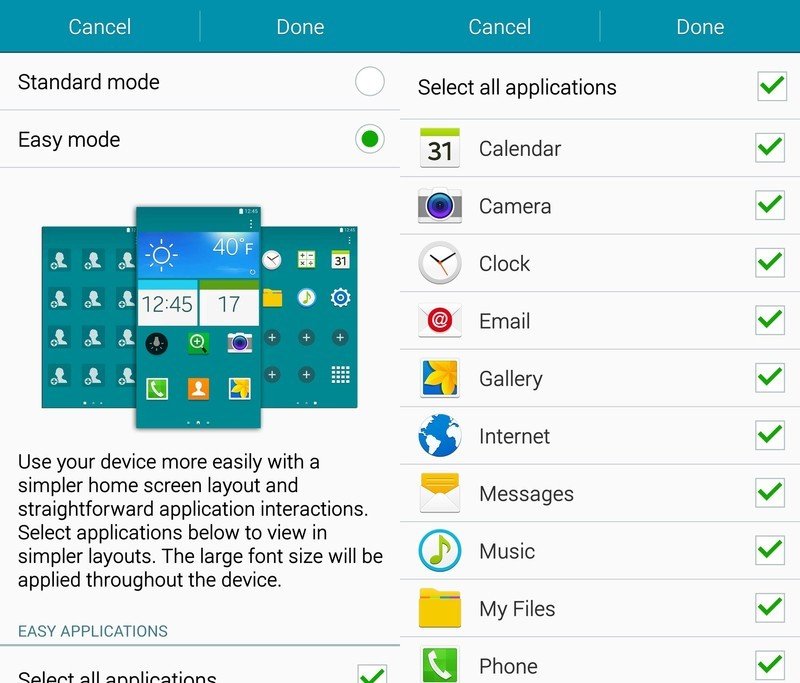How to enable Easy Mode on the Note 4 (and why you might want to)

Whether it's for a short time or permanently, Easy Mode keeps things simple on your phone
We all have a seriously powerful computer in our pockets, and the Galaxy Note 4 takes that notion to the extreme with its laundry list of features backed up by high-end internals and a large screen. We know not everyone needs access to all of those features at once, though, and luckily there's a simple way to scale down the experience with Samsung's "Easy Mode" on the Note 4.
Whether its because the phone will be used by a less-experienced user or you just want to simplify things for yourself for a short period of time, Easy Mode will give your phone an easier-to-handle home screen experience, basic settings and access to just the things you need with fewer frills. Best of all it's easy to switch between Easy Mode and your standard home screen layout without losing any data or settings. If you (or someone you know) may have a use for Easy Mode, be sure to read along and get all the details on how to use this feature on your Galaxy Note 4.
Enabling and disabling Easy Mode

To enable Easy Mode on the Galaxy Note 4, simply head into Settings and scroll down to the "Personalization" section, then tap Easy Mode. You'll then have the option of toggling between Easy and Standard Mode, and choosing which apps will be placed on the launcher when you enable Easy Mode.
Tap the Easy Mode button, select the apps you want to have on the home screen at first launch (you can change these later) and hit Done at the top of the screen. After a few moments your phone will return to the home screen, showing you a new but familiar experience that's simpler to navigate and use.
By default you'll have access to just three home screens, with the main one being used for a set of three widgets — weather, clock and calendar — and six apps — flashlight, magnifier, camera, phone, messages and the Internet browser. The home screens to the left are devoted to a grid of favorite contacts, which you can select on your own, and to the right you'll see a more standard app grid that is three apps wide and four apps tall. The standard dock and app drawer icon are gone from the bottom of the screen — you can get to the app drawer from the More apps button on the rightmost home screen instead.
The notification pane, quick settings toggles and hardware buttons all work the same in Easy Mode, meaning you won't have to change the way you use the phone's basic functions when switching modes. You will notice that the Settings menu has a slight visual change, though, surfacing the most important and often-used settings options and hiding the rest behind a "More settings" button if you need them.
Be an expert in 5 minutes
Get the latest news from Android Central, your trusted companion in the world of Android
Even those who need an Easy Mode likely want to customize things to their liking, though, and this mode does enable you to do just that.
Configuring your phone in Easy Mode

Easy Mode makes it pretty clear where things can be tweaked, using giant + signs on empty spots on the home screens indicating there is content that can be added. On the left-of-center home screens you'll be able to tap these spots to add individual favorite contacts, and on the right-of-center ones you'll have the option to add apps — in either case you can't add widgets or manipulate the ones on the main home screen.
When you tap an empty space on the home screen to add an app, you get a simple alphabetized list of every app you have installed, which you can scroll through manually or search using the box at the top of the list. Tap an app you wish to add and it'll be put into the space that you tapped — you'll then be taken back to the home screen. If you want to access an app from time-to-time that doesn't warrant being pinned to the home screen, simply hit the More apps button in the bottom right corner of the screen.
To remove and rearrange apps and home screens, tap the menu button — which looks like three vertical dots — in the top right corner of the screen and tap Edit. You'll then be able to tap the - button over any app that can be removed, and its shortcut will be replaced with an empty space where you can then add an app of your choice. The only exceptions here are the pre-installed widgets and the Flashlight and Magnifier apps. It may not be as intuitive if you're used to the long-press drag-and-drop method of moving apps on a home screen, but this way there's plenty of clarity as to how to move apps around.
While still in the edit mode, you can add an additional page of favorite contacts on the left side by hitting the Show button at the top of the screen, or add up to two additional pages of apps on the right by using the same button at the top of each.
Going back
If you ever need to go back to your standard home screen arrangement, simply head into the settings, find Easy Mode again and switch the button back to Standard Mode and hit Done. Your normal home screen layout will all be returned, whether you use the pre-installed launcher or another one of your choice — no additional setup required.
Andrew was an Executive Editor, U.S. at Android Central between 2012 and 2020.

